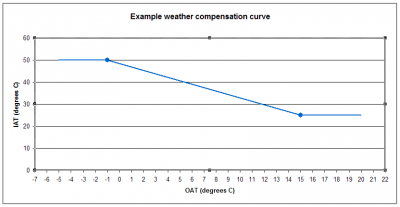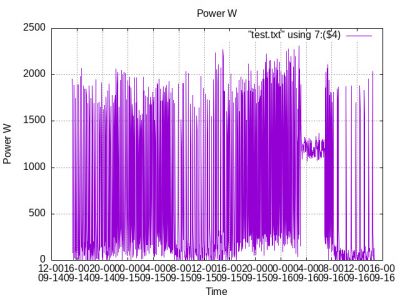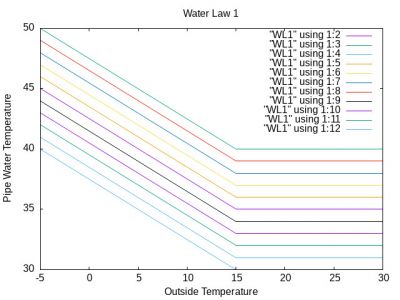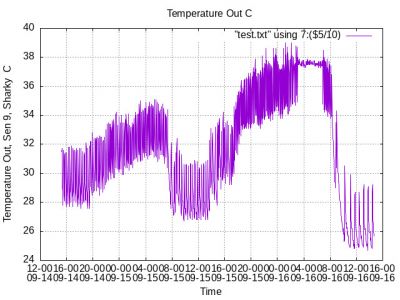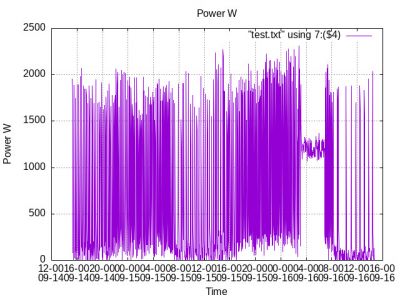Posted by: @iantelescopeI have again reduced the /water Law Defining coordinates to [+17:25] .
Currently , my room Temperature has reached 24.5 C , too hot even for me.
But , the System does heat, albeit with a maximum Consumed power of 200 Watts and an output Water power of 150 Watts.
Noted
As posted above your sharky data, or your interpretation of it, is incorrect. Thus your 'water power' is likewise incorrect.
Sensor 3 is showing a higher value than sensor 1 which is impossible, but perhaps the difference is within the accuracy expected. @derek-m is more familiar with the accuracy of temperature sensors than I am so will doubtless comment with more authority. We need to bear in mind this inaccuracy when interpreting the results.
Please confirm the water law offset is now set to zero.
Have you any idea when we might be able to get IAT and OAT measurements?
4kW peak of solar PV since 2011; EV and a 1930s house which has been partially renovated to improve its efficiency. 7kW Vaillant heat pump.
Could you please provide the OAT and IAT data (which you stated you would do several days ago) as soon as possible so that we can move forward.
The Outside Temperatures on the evening of the 15th Sept started at +14.1 C dropping to 11 C in the early morning.
The Room Temperatures started at 22 C on the evening of the 15th increasing to an astonishing 24.9 C in the early morning.
I cannot accurately measure or store the outside or Inside Temperatures. at present.
Conclusions:
1) From the Rapid Temperature rise to an unacceptable ~25 C with an outside Temperature of 11 C I definitively Do need some form of Room Temperature Control!
2) I also need the Temperature Control to use my Octopus "Cosy" Off peak " tariffs.
I have ordered another Arduino and a Arduino another Shield and another "Noise" reducing Aluminium box .
However, I will need some time to build the device.
I have just been told that my new Radiator to replace a leaking old Radiator has been lost in the postal system.
Try to understand .......................I am not trying to upset either you, @derek-m or @jjamespa.
This is NOT "X" or "twitter".
Posted by: @iantelescopeTry to understand .......................I am not trying to upset either you, @derek-m or @jjamespa.
This is NOT "X" or "twitter".
As you have not responded to the very simple question asked in my immediately previous post, I can only presume that you haven't bothered to read it. This being the case you are certainly upsetting me, as I think I have probably been wasting my time for the past 75 pages.
4kW peak of solar PV since 2011; EV and a 1930s house which has been partially renovated to improve its efficiency. 7kW Vaillant heat pump.
Like James, I can find it frustrating when you do things that we have NOT asked you to do and fail to do the things that we DID ask you to do.
Could you not use two of the return temperature sensors to measure IAT and OAT?
I would have preferred to wait until we have all the relevant information before making an assessment and drawing any conclusions about your system, but here is my preliminary assessment.
Sensor 1 is reading at least 1C low, but since it is a thermocouple this is probably well within its specified tolerance.
The other temperature readings appear to be reasonably accurate.
The thermal energy measured by the Sharky is most definitely not in the 150W to 200W range, maybe multiply the reading by 10. I would suggest that you look at the data actually displayed on the Sharky and see what that is saying.
I also suspect the measurement of electrical energy is incorrect. Please provide details of how this is being obtained.
The period from 04:00 to 08:00 was when your heat pump was producing more thermal energy than when it is operating at minimum output. It was therefore no longer cycling. This was because the OAT had fallen to a level where the WC raised the LWT and hence put more loading upon the heat pump.
As you discovered, this caused more thermal energy to be transferred to the heat emitters, which caused IAT to increase because the actual thermal energy demand was lower than that being supplied.
I would be obliged if you could possibly carry out the following test.
If you have a suitable switch (maybe a light switch or similar), could you connect the shorted wires at the room thermostat to either side of this switch, such that the switch can be used to enable and disable the heat pump. DON'T FORGET TO SWITCH OFF THE POWER BEFORE WORKING ON THE WIRING
Once the switch is in place, set the WC offset to +5C and enable the heat pump for 10 minutes. After the 10 minute period disable the heat pump using this switch and monitor the various water temperatures. When the temperature on sensor 7 falls by 5C then re-enable the heat pump. Continue this process for several hours and then post the results.
@iantelescope - I fear to weigh in, but, hey ho... Let's start with some basics.
1. Inside and outside air temps (IAT and OAT) are fundamental to running an air source heat pump. They are the alpha and the omega of weather compensation (or in Samsung's bizarre lost in translation terminology, water law). Recording them should be a primary objective, far more important initially than getting bogged down in Snarky stuff, Faraday cages and piling Pelion on Ossa (or, in your case, arduino on arduino). A pair of simple data loggers (one for IAT, the other for OAT) will collect hourly temperatures for you, which you can download to a PC over USB and plot until you are blue (or red, depending on the IAT) in the face. They are not that expensive, and while not waterproof, I am sure you could rig up some form of basic Stevenson screen to protect the one placed outside from the elements. You wont get real time live data on your PC, but you will have a consistent time series of IAT and OAT data, up to the latest download from device to PC. Something like this Elitech RC-4 Temperature Data Logger.
2. I strongly suspect the reason why you IAT has overshot recently is because your weather compensation curve (let's not get bogged down in branded proprietary jargon) end points are wrongly set. Weather compensation is a simple idea: as the OAT falls, heat loss from a building increases, therefore more heat needs to be added to the building to maintain a constant IAT. There is of course more to it than that, and every building is different, but that's the basic idea, and a very good one it is too. As the OAT goes down, the heat injected into the building goes up. The way this is done is by increasing the LWT (leaving water temperature, the temperature of the water as it comes out of the heat pump after being heated), and as a result the emitters (rads and/or UFH) get warmer, and then the IAT get warmer.
3. I cannot determine from you posts what your current weather compensation curve end points are. These are conventionally given as two points on the curve (never mind its a straight line linear relationship), in the format "xx @ yy," where xx is the LWT at yy OAT, for example "45 @ -1" means a LWT of 45 degrees when the OAT is -1 degrees. The curve can be visualised as a simple plot, like this, showing a left hand (colder OAT) end point of "50 @ -1" and a right hand (warmer OAT) end point of "25 @ 15", with the curve flat-lining beyond the end points (as it does on my heat pump, according to the manufacturers, others may vary):
4. This is a hypothetical curve, because all buildings are different, and the only way of finding the right end points is by trial and error. If your IAT is too high when it is relatively mild outside, then your right hand end point is almost certainly too high: you need to try lowing it a bit. Had the IAT been too low, then you would need to raise the right hand end point a bit, and so on. Because heat pumps are 'slow and steady' devices, you need to wait some considerable time (days not hours) to note the effects of any changes. Over time, you gradually tweak the curve to one that works for your building, in your location.
I would be very pleased if you can state in clear terms what your weather compensation curve end points are now, and then let us know what happens when you change them. For now a manual reading of IAT will suffice, plus or minus a local Met Office weather station for OAT if you can find one as a proxy for your OAT. You can find your nearest weather station on the Met Office WOW web site. Once you have data loggers in place, the data collection will happen automatically, and all you have to do is download it.
Bottom line, cut the cr&p, tell us what is actually going on in simple terms (IAT vs OAT), and then what you have done to improve things by tweaking the weather compensation curve end points, and the subsequent effects on IAT.
1558h: edited to remove annoying auto formatting
Midea 14kW (for now...) ASHP heating both building and DHW
Scientific Notation again!
I must again apologise for misreading the instructions for the Sharky.
All of the Returned data is returned in a Scientific notation , e.g. 120 e-1 , 14 e +2 etc Except Power , which is returned without a Scientific representation.
The e--3 ,e-2 and e-1 scientific terms are separately returned in a text returned from the Sharky.
Consequently the Power should be :
Note the 10 fold increase in Power.
I will have to fit a switch to prevent the Heat Pump from Stopping Cycling , as per last night.
Stopping cycling is not , surely, a good idea.
As I stated, fitting a switch is a test. If you are going to question every piece of advice that I give then I'm afraid that you are just wasting my time.
Weather Compensation curves:
Hi @cathodray, yes! I am painfully aware of the Consequences of playing with the Weather Compensation , aka Water Law curves!!
Having used , and abused them, for the last two years!
At the moment I am shorting the Physical Room Thermostat to test the idea, courtesy of @jamespa , that my heat pump could be controlled Only by the Weather compensation curve.i.e without a Thermostat.
Last night the following resulted:
My Room Temperature soaring to 25 C while the Heat Pump stopped Cycling :
Experiments are continuing ..............
ian
Posted by: @derek-mDid you every get the problems with your system resolved?
Yes and no. I have a system that works fine, except when it is very cold outside, which I continue to think happens because the heat pump is marginally under-specified. I still have the plate heat exchanger and so separate primary and secondary circuits, having decided to live with this setup, at least for now (I like the fact they are separate, one doesn't contaminate the other, even if I take an efficiency hit). COP averages out at around 3 which I can live with, total bills remain high because of my choice to live in an old leaky building, which I am slowly, albeit very slowly, making less leaky. The monitoring has run perfectly with the two exceptions of (1) setting up an independent modbus OAT sensor (I'm still using Midea's sensor), because I haven't worked out physically where to place it, and (2) setting up a modbus enabled heat pump kWh meter (I still use the Midea data, double checked against weekly manual readings of the non-modbus heat pump kWh meter), mainly due to slothfulness and ineptitude on my part. Once I have set up the modbus OAT sensor, I plan to complete that magnum opus that is my attempt to describe what I did so others who want to have a go at using a modbus/python system at least have some pointers on how to go about it.
Midea 14kW (for now...) ASHP heating both building and DHW
Posted by: @iantelescopeAt the moment I am shorting the Physical Room Thermostat to test the idea, courtesy of @jamespa , that my heat pump could be controlled Only by the Weather compensation curve.i.e without a Thermostat.
This should have been accepted on page 1, not 'testing the idea' on page 76. The room stat should almost invariably not be used to control a heat pump except in two very particular circumstances, both of which are in effect using the room stat as an on/off device:
(1) seasonal on/off: set the room stat ludicrously high (30 degrees?) when you want the heating off, and sufficiently low, 12 or so degrees, when you want it on, but always leaving the amount of heat to be delivered down to the weather compensation curve. You do not want the amount of heat delivered controlled by having a room stat cycle the heat pump on and off - you are guilty of adding short cycling, and both performance end efficiency will take a serious hit. Room stat control of room temp is for fast and furious fossil fuel boilers, and does not work with low and steady heat pumps
(2) overnight setbacks, if you want to use them: setting the room stat to say 16 degrees between 2100 and 0300 will allow the building to cool a bit overnight, producing an apparent saving. Whether that might actually save you any money is a moot point that has been discussed very many times on this forum, and no doubt elsewhere.
As I am sure you (and @jamespa) appreciate, you don't need to physically short the room stat (what could possibly go wrong?), all you need to do is set it high enough, and then it will effectively short itself (be always on).
Tweaking a weather compensation curve initially might take months (and might even need further very occasional tweaks), but for it to take two years or more suggests strongly that you are an Eric Morecambe among heat pump owners, you might be able to play all the right notes, but not necessarily in the right order.
You still have not said what your current weather compensation curve end points are.
Edited to say "all you need to do is set it high enough, and then it will effectively short itself (be always on)" after an alert @jamespa noted I had wrongly said "all you need to do is set it low enough, and then it will effectively short itself (be always on)"
Midea 14kW (for now...) ASHP heating both building and DHW
- 26 Forums
- 2,342 Topics
- 53 K Posts
- 421 Online
- 6,000 Members
Join Us!
Worth Watching
Latest Posts
-
Controlling Daikin Altherma via P1P2 and Home Assistant
Are there any fellow Daikin Altherma 3M owners who are ...
By weoleyric , 17 minutes ago
-
RE: Configuring third party dongle for Ecodan local control
However, I've found the documentation doesn't work exac...
By F1p , 1 hour ago
-

RE: Setback savings - fact or fiction?
@robs — thanks again for your detailed comments. Some r...
By cathodeRay , 2 hours ago
-
RE: Are We Sleepwalking Into Another Race to the Bottom?
The thing that worries me is that this brainless crap i...
By JamesPa , 3 hours ago
-
RE: Free Ecoheat Heat Pump Install
I don't mind thread drift, it's how conversation natura...
By Deltona , 4 hours ago
-

RE: A Smarter Smart Controller from Homely?
@papahuhu I hope you get a swift resolution. Regards, T...
By Toodles , 6 hours ago
-

RE: Poll for Time of Use, tariffs, technology
That’s fine by me too Major, I feel it is a sad reflect...
By Toodles , 7 hours ago
-

Bingo. Sometimes a judiciously placed size 10 bovver bo...
By Majordennisbloodnok , 7 hours ago
-
RE: Mitsubishi Ecodan 11.2kW heat pump with low COP
@ciocoiu-alexandru I can't provide the same level of di...
By Sheriff Fatman , 8 hours ago
-
RE: Octopus Cosy Heat Pump Owners & Discussion Thread
Recently had my follow up with octopus for the vibratio...
By swwils , 9 hours ago
-

The three technical issues I'm considering are: BMS...
By Transparent , 10 hours ago
-
RE: LiFePO4 lithium battery fires and explosions
@transparent Your post may fit better in th...
By Batpred , 10 hours ago
-

RE: British Gas vs Octopus Energy vs Heat Geek vs EDF vs Aira vs OVO vs EON.Next vs Boxt
@jamespawhite, if you could be bothered, you could also...
By Mars , 12 hours ago
-
RE: Commencing on an ASHP Installation Process
I've got a bit of time to draft something today, so the...
By Sheriff Fatman , 1 day ago
-
RE: Help with heat pump sizing
@amin I dont think materially relative to t...
By JamesPa , 1 day ago
-

@majordennisbloodnok I have decided to take the plunge....
By TechnoGeek , 1 day ago
-
RE: Different dT on each radiator?
I cant sorry. Its based on some calculations I did fro...
By JamesPa , 2 days ago
-
RE: Help me keep the faith with my air source heat pump installation
@simonf thats interesting as I’ve noticed my flow and r...
By AdamK , 2 days ago


